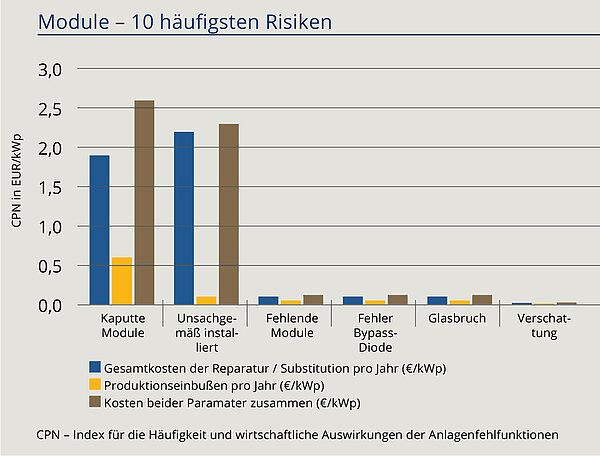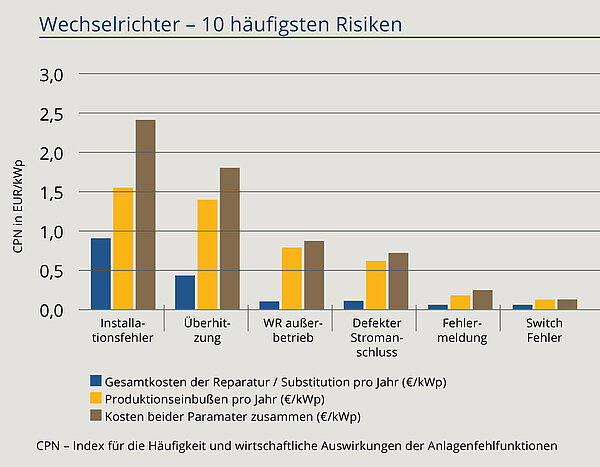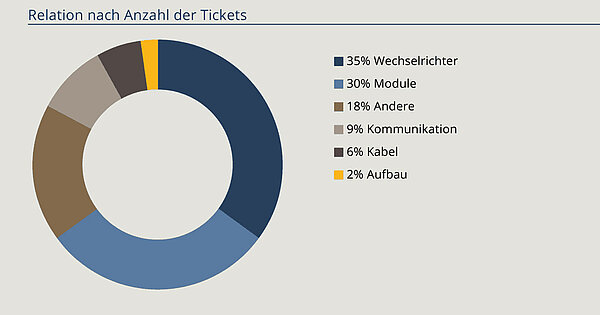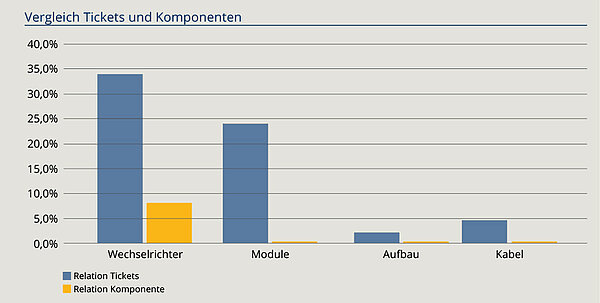Smart"er" PV Energy: Mobility, Heating, and Storage
Once the PV yield is captured and monitored, the next step is to consume the electricity. Here there are different options depending on the desire and the system. When it comes to the use of PV power, the "smart home" sector has certainly made the greatest developments. For example, battery systems, heat pumps and electric cars - all of which can be fed with self-generated PV electricity - have increasingly found their way into private households and industry, especially in recent years.
Electromobility: Greener with PV Energy
In the course of this development, pure Solar-Log™ PV monitoring has transformed into a comprehensive energy management system. In addition to monitoring, this also allows consumers to be controlled and their demand to be recorded. The integration of charging stations for e-cars plays an important role here. Thus, the energy management system, i.e. in combination with a KEBA charging station, ensures optimized charging of the electric vehicle. With the so-called charging current limitation, the e-car is charged with minimum charge even if no PV energy is available. As soon as a surplus of PV energy is available, the charging station receives a corresponding release from the energy manager. Thus, the vehicle is charged with the available surplus PV energy. In addition, data such as charging can be recorded and visualized.
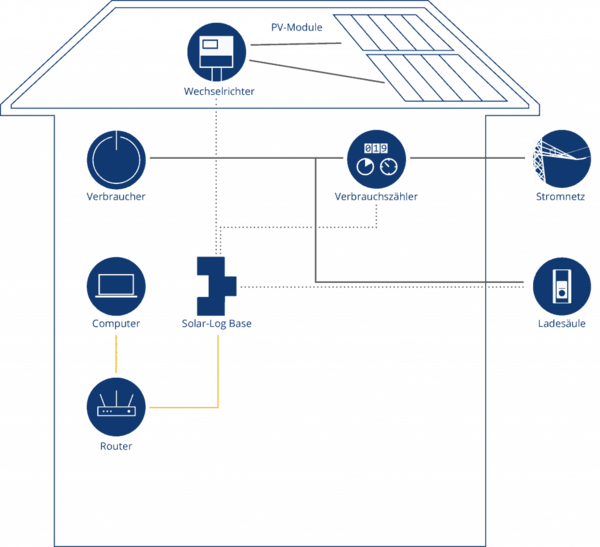
Effective charging of the electric vehicle with the Solar-Log™ energy management system. (Source: Solare Datensysteme GmbH)
Saving Energy with Targeted Heat Control
Further potential to use PV energy directly is offered by the combination of photovoltaics and heat pumps. The basic idea is that the electricity-intensive heat pump is operated with PV electricity. Depending on how the heat pump is connected to the energy manager, either an enable signal or the excess power is given to the heat pump in this case. Heat pumps from the manufacturers IDM, CTA, Hoval and Stiebel-Eltron are connected to the Solar-Log™ system via their protocol.
Predictive Operation with Weather Data
In addition, local weather forecast data can be included with the Solar-Log™ Energy Manager and a heat pump from the manufacturer IDM. The weather data is calculated hourly and for two days in advance. The forecasts based on this enable predictive control of the heat pump. In practice, for example, the heat pump can be set to start at 10 a.m. if high solar radiation is forecast at that time. This prevents the heat pump from drawing its drive energy unnecessarily from the power grid.
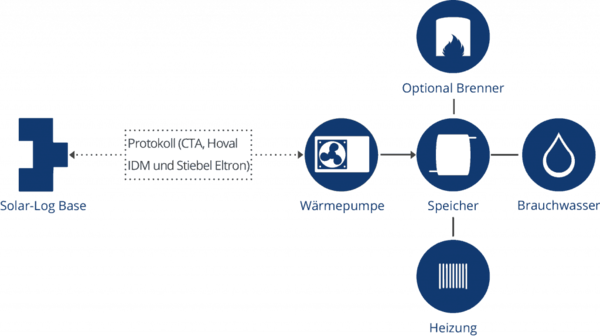
Depending on the manufacturer, the connection of a heat pump is possible via protocol, among other things. (Source: Solare Datensysteme GmbH)
Store PV Energy Effectively
The operation of a heat pump enables the storage of PV energy in the form of heat, but it is of course also possible more directly with a battery storage system. Such storage systems are the most effective solution for independent use of PV power. The biggest advantage is obvious: the electricity can be "collected" and is thus available regardless of the time of day and solar radiation. By integrating the battery storage unit into the Solar Log™ system, measured values such as the current charge level and the charging and discharging performance are directly recorded and displayed. As a helpful analysis option, the Energy Manager also displays the charging history for one and seven days. The system operator receives other important information, such as the electricity savings from battery use and the efficiency of the battery solution itself. The user can see the amount of energy he was able to draw from the battery and what he saved in terms of electricity costs.
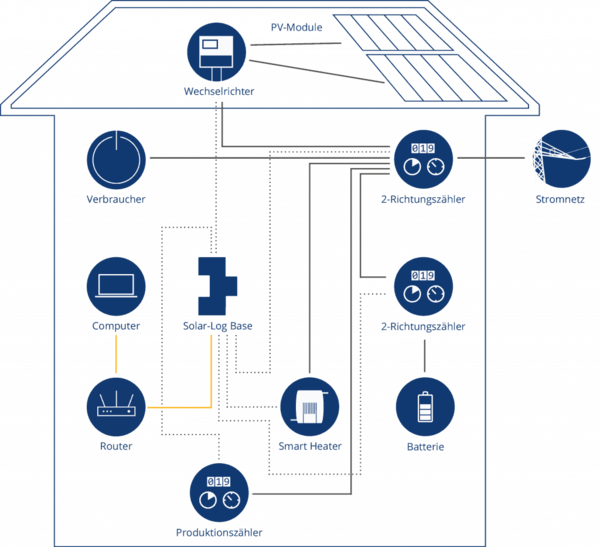
Current charging status and the charging and discharging power are recorded and output by the Solar-Log™. (Source: Solare Datensysteme GmbH)
Direct Marketing: Selling PV Energy Directly
In addition to the numerous possibilities in the "Smart Home" area, the marketing of PV energy offers another application option. Direct marketing is particularly interesting for operators of larger systems who do not consume the PV energy themselves, or only partially.
How does direct marketing work?
As the name implies, direct marketing involves marketing the electricity directly or selling it on the electricity exchange. This includes electricity from alternative energy sources such as photovoltaics, wind energy, biogas, or hydropower. In principle, direct marketing allows every owner of a PV system to sell his PV electricity. However, in order to be able to market the electricity on the electricity exchange, several players and the corresponding technical equipment are required.
Stakeholders include the PV installer, direct marketer, solution provider for connectivity. The grid operator and direct marketer must have the ability to control the PV system. Each individual regulation of the plant must be logged. Finally, there is the administrative effort to register the plant for direct marketing. Thus, until now, the path to direct marketing was often complicated and cost-intensive, so that it was actually only worthwhile for large PV systems. In order to simplify this previously complicated path in the future and thus make direct marketing of electricity interesting for more plant operators, Solare Datensysteme offers a simple solution with its partner EnBW virtual power plant offers a simple solution. This is based on two components:
- With the Solar-Log™ energy management system, there is a technical solution.
- Through the embedded direct marketing platform, the complete registration process can be carried out directly online. Through this platform, the plant operator constantly receives all information about the marketing of the PV energy.
The Solar-Log™ Base energy manager has all the technical prerequisites: delivering the information from the PV plant to the direct marketer, and ensuring that the plant can be controlled by the marketer. The VPN function required for data transmission is already integrated in the new energy manager. This eliminates additional costs for a special VPN modem.
The right solution for every PV system and every wish!
The various solutions show how flexibly and individually PV energy can be used. However, one also loses the overview quite quickly and inevitably the questions arise: what is now the right solution for my wishes and PV system? How can I use the PV power most effectively? How do I implement this? Here the call to the installer helps (find an installer near you here ). He can work out a solution based on the technical system data and the desired use of the PV electricity and, if necessary, implement it. With the Solar-Log™ monitoring and energy management solution, you have all the options in your hand.

Back to the overview


